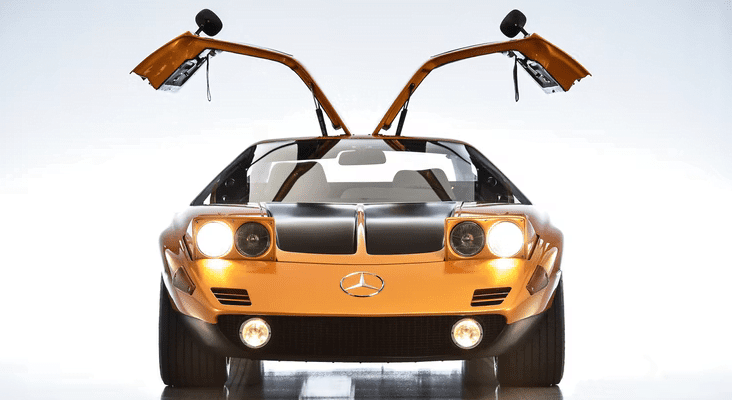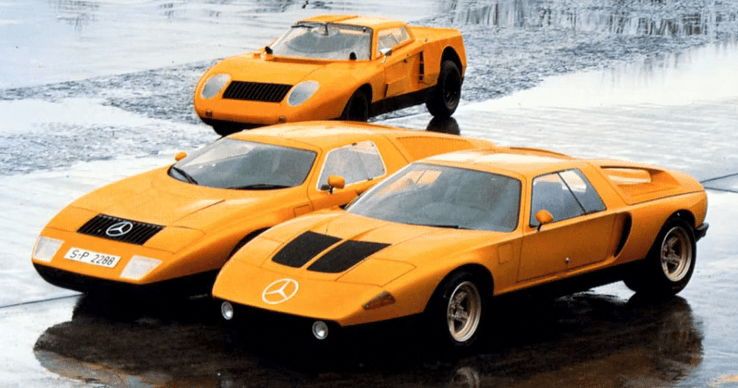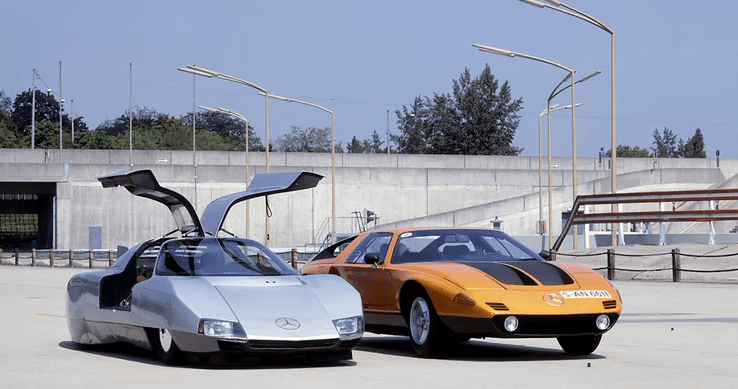The 1970 Mercedes-Benz C111 II secretly formed the automotive world, whether you like it or not…
A Wankel rotary engined Mercedes-Benz might seem absolutely insane to think about nowadays, however, in the 1970s, it was far from crazy, the German manufacturer wanted to try out some unique ideas. They created the Mercedes C111 concept car, a super car that represented test and trial, just think of it as a science experiment that can go quick. Mercedes wanted to bring back a couple of old and timeless ideas into their design and styling, while also incorporating new and fresh ideas to appeal in the unique decade of the 1970s. Trying out new ideas, mechanics, and designs can be a stressful thing, so Mercedes created the C111, a car that could do it all. They derived the Gullwing doors and wide door sills from the 1955 Mercedes-Benz 300SL Gullwing, and included that timeless styling with never done before ideas and unique concepts into one car. What could go wrong?
Built and produced under the name C111. These cars never went into production, but that same technology that was integrated into them, is still used to this day in all of our daily drivers. Forget about its futuristic and fascinating design and shape, it was the technology that shaped the automotive world, what could have been this car is still left to our imagination. Think of this car as the Porsche 959, a versatile super car that shaped the entire company and brought technological evolutions to the automotive table. The only thing that’s different is that the Mercedes C111 was never able to show its full potential, and could have been a car to do extraordinary things. However, it’s story and legacy still stands and will end as a “what if”. Mercedes was experimenting with new engine technologies, including Wankel engines, diesel engines, and turbochargers, and used the basic C111 variations as a test bed, it was never meant to be a car for the gruesome roads.
Wearing a rather conspicuous bright orange livery on its debut at the 1969 Frankfurt Motor Show, many wondered that this supercar was finally the ultimate successor to the iconic and desirable 1955 Gullwing. With great success came great disappointment, this wedge supercar was a worthy successor to the Gullwing, but had one downside. It was just a prototype. This cutting-edge car was powered by a three-cylinder Wankel engine that produced a total of 280bhp, pushing the car to a top speed of 160mph. Might not seem like a lot, especially in this day and age, although with its innovative lightweight glassfibre body this wedged car was quick beyond belief. And still quick by today standards, you could cruise and also thrust this novel supercar through windy roads and hairpins thanks to its nimble and lively body, while hearing that crude rotary engine through the body panels. Mercedes tested diesel engines on the later versions, they brought new handling, and an experimental suspension system as well. To be frank, every time you saw this car, it had a different engine each time thanks to all the series made and all the technology it was tested with.
You can say in 1970, the C111 Series 2 was the best and most advanced model yet. C111-II arrived from the shadows, showing off its more powerful 370bhp four-rotor engine, improved aerodynamics and rounded bodywork to the world. Even though it seemed as it was ready to conquer the world, the technology and configurations were still in development for quite a while. Despite the fact that these cars’ details were perfect and everything was refined to the tee, with air-conditioning and a comfortable leather interior, they never made it into the hands of salesman. Even though the Wankel engine was smooth and fast, it was unreliable and extremely thirsty. And that was the reason that held back these cars, Mercedes was so keen into trying out and introducing that engine, but at the end of the day they werent as good as the notable V, Inline, or flat engine configurations.
After the failure that came along with the Wankel engines, Mercedes didnt go back to their original or traditional configurations, but to diesel engines instead. Mercedes added the 3-litre engine from the Mercedes 300 D and added a turbocharger and intercooler to increase the power output to 190bhp at their disposal. The most powerful variation yet had a total of 345bhp at 7000 rpm, and 289lb feet of torque, combine that with the 5-speed manual transmission this car had so much unresolved potential. The diesel versions were the least powerful, but much more reliable than the rotaries, with the mid-mounted four-rotor direct fuel injected C111 being the most quick and powerful out of the series’. Its aerodynamic bodywork that came with the second series gave it an air drag coefficient of 0.191, the C111 eventually reached 200 mph at the Nardò Ring in 1978, but that was the last time this car really showed it true ability.
Linear, smooth, comfortable, unique, fast, beautiful, and orange. What more could you ask for in a car? The closest it came to seeing a long stretching road was in 1991. Mercedes-Benz decided to introduce the C112 at the Frankfurt Motor Show in 1991 as a production sports car. The car included a mid-mounted 6.0 L V12 engine, way different from the engine units it was tested with decades before. After receiving and accepting deposits from 700 eager costumers, the German company decided not to put or proceed the C112 as a production car. No matter what engine or decade this car had or was in, it still got unlucky with being a production car. No one knows what this supercar could have achieved, but all that we can do now is look at those black dipping nostrils, sloping bonnet, hollow rear pillars, and that orange paintwork that accentuates this car’s contemporary, rounded, and edgy features.
We all have dreamt enjoying this car on this street, but we all should thank its innovational stance and legacy for being the inspiration and test bed for all the cars we enjoy and love today.




